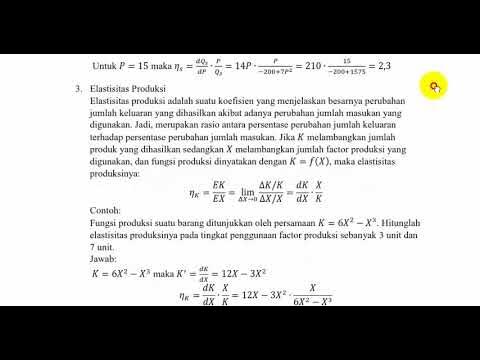Paul Solman - elasticity pt1
Summary
TLDRThis script explores the concept of elasticity in economics, particularly price elasticity of demand and supply. It uses examples like ice cream cones and natural gas to illustrate how quantity demanded changes with price. The discussion also covers how elasticity varies with the scale and the real-world impact of severe weather on natural gas prices. The script explains elasticity coefficients, using Major League Baseball ticket sales as an example, and concludes with a quiz to test understanding of elasticity for various goods.
Takeaways
- 📈 Elasticity in economics refers to the responsiveness of quantity demanded or supplied to changes in price.
- 🍦 Price elasticity of demand is demonstrated by the slope of the demand curve; as price increases, quantity demanded decreases.
- 📊 The angle of the demand curve's slope indicates the degree of elasticity, with steeper slopes showing less elasticity.
- 🌡️ In 2000, natural gas prices spiked due to severe weather conditions that increased demand for gas.
- 📉 The demand for natural gas is price inelastic, meaning consumers are less responsive to price changes.
- 🏈 An example of price elasticity is given by Major League Baseball ticket sales, where a 1% increase in price results in a less than 1% decrease in quantity demanded.
- 🥖 Basic necessities like bread have low elasticity coefficients, indicating inelastic demand.
- 🚗 Non-essential items like auto repairs and movie tickets have higher elasticity coefficients, showing more responsiveness to price changes.
- 🍽️ Expendable luxuries, such as restaurant meals, have high elasticity coefficients, indicating elastic demand.
- 📊 Elasticity coefficients are calculated at the current price, as elasticity can change along a linear demand curve.
- 🌡️ Essential goods and services, like life-saving medical care, tend to have inelastic demand curves due to their necessity.
Q & A
What does the term 'elasticity' mean in economics?
-Elasticity in economics refers to the responsiveness or sensitivity of quantity demanded or supplied to changes in price.
Why are supply and demand schedules usually sloped?
-Supply and demand schedules are usually sloped because quantity demanded and supplied typically respond to changes in price.
How does the price of ice cream cones relate to the concept of price elasticity of demand?
-As the price of ice cream cones increases, the quantity demanded decreases, demonstrating that consumers exhibit price elasticity of demand.
What would a perfectly vertical supply schedule imply about price elasticity?
-A perfectly vertical supply schedule would imply that suppliers are not responsive to price changes, showing no price elasticity of supply.
Why did natural gas prices spike to historically high levels in the year 2000?
-Natural gas prices spiked in 2000 due to severe weather conditions that increased demand and reduced supply from substitute sources.
How does the elasticity of demand for natural gas differ from other goods?
-The demand for natural gas can be unusually inelastic, meaning consumers are less likely to reduce their consumption in response to price increases.
What is the elasticity coefficient and how is it calculated?
-The elasticity coefficient measures the responsiveness of quantity demanded or supplied to changes in price, calculated as the percentage change in quantity over the percentage change in price.
What does an elasticity coefficient of less than one indicate?
-An elasticity coefficient of less than one indicates that the demand or supply is inelastic, meaning quantity changes less than price.
How did Major League Baseball ticket sales respond to a 1% price increase?
-A 1% price increase in Major League Baseball tickets resulted in a decrease in sales by about 64 fans per game, indicating an inelastic demand.
Why does elasticity change along a straight-line demand curve?
-Elasticity changes along a straight-line demand curve because the percentage change in quantity demanded relative to price changes varies depending on the point on the curve.
What is the significance of a demand curve being price inelastic?
-A price inelastic demand curve signifies that consumers are highly dependent on the product and are less responsive to price changes, often due to a lack of suitable substitutes.
Outlines

هذا القسم متوفر فقط للمشتركين. يرجى الترقية للوصول إلى هذه الميزة.
قم بالترقية الآنMindmap

هذا القسم متوفر فقط للمشتركين. يرجى الترقية للوصول إلى هذه الميزة.
قم بالترقية الآنKeywords

هذا القسم متوفر فقط للمشتركين. يرجى الترقية للوصول إلى هذه الميزة.
قم بالترقية الآنHighlights

هذا القسم متوفر فقط للمشتركين. يرجى الترقية للوصول إلى هذه الميزة.
قم بالترقية الآنTranscripts

هذا القسم متوفر فقط للمشتركين. يرجى الترقية للوصول إلى هذه الميزة.
قم بالترقية الآنتصفح المزيد من مقاطع الفيديو ذات الصلة
5.0 / 5 (0 votes)






